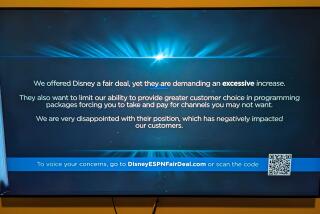Getting well-connected
- Share via
When it comes to choosing broadband Internet providers, you can’t always get what you want. But with certain limitations, you can get what you need.
If you use the Internet regularly, chances are you already have broadband -- that is, a high-speed hookup, usually through your cable television provider or phone company.
But are you getting it at the right speed and right price? There are more choices than ever, even though you typically have to go with a provider that serves your neighborhood.
For example, if you live in or are moving to a neighborhood where AT&T; Inc. provides hard-wired phone lines, it’s generally your only source for phone-based broadband service. Too bad if you want the superfast fiber-optic Internet service offered by the rival phone company, Verizon Communications Inc. -- you can’t have it.
You can, as an alternative, go with the cable provider that serves your neighborhood. But there’s only one of those, too.
It’s almost un-American.
But take heart, comparison shoppers. Your range of broadband providers may be limited, but you have several choices in regard to speed and price.
So if you’re shopping for broadband for any reason -- including a relocation, to see if you’re getting the best deal, or if you don’t have it yet -- here’s a step-by-step guide to high-speed service.{ PROVIDERS, SPEEDS, COSTS AND BUNDLING UP, PAGE C4 }
Corralling a connection
This guide is tailored to consumers in Los Angeles, Orange, Ventura, San Bernardino and Riverside counties, but these tips can be applied across the U.S. The choices may not be bountiful, but you might as well make the best of what you’ve got.
--
STEP 1 Know your local phone company.
It used to be that just about everyone could name his or her land-line phone provider, but that was before cellphones and Internet calling became so popular.
Now, many households bypass the land-line companies altogether by going all-cell or using online phone companies such as Vonage Holdings Corp.
Two land-line phone companies offer broadband -- AT&T; and Verizon -- and the vast majority of residences are covered by one or the other. To check which one is in your neighborhood, you can give them a call. AT&T; can be reached at (877) 722-2256. Verizon is at (800) 483-4000.
You can also check their websites. They allow you to type in your home address to see what’s available.
On AT&T; the site is at www.att.com. Click “Internet,” then “Check availability.”
For Verizon, the site is www.verizon.com. Click on “High speed Internet,” then enter your phone number or address.
If the company services your area, you’ll immediately be offered phone, Internet and other products. If not, you’re likely to get a vague message about “unable to locate the address” or having “technical problems.”
--
STEP 2 Know your local cable company.
There are three in the area: Charter Communications Inc., Cox Communications Inc. and Time Warner Cable Inc.
For Charter, check at (888) 438-2427 or www.charter.com.
Cox is at (888) 269-5757 or www.cox.com.
Time Warner is at (888) 892-2253 or www.timewarnercable.com.
--
STEP 3 Pick your speed.
Back in the ancient days of the consumer Internet -- the mid-1990s -- a dial-up modem operating at 14.4 kilobits per second was hot stuff. It had little trouble delivering the text e-mails and primitive bulletin boards where the early online arguments about politics, religion, cats and other inflammatory topics raged.
But 14.4 would hardly cut it now that the Internet is chock-full of music and video, including live TV. Today’s broadband speeds for the home generally start at 768 kbps and go up to 50 mbps (that’s 50 million bits per second).
As a rule of thumb, the more speed, the more money you pay. For example, with Time Warner, 768 kbps service costs $24.95 a month. Boost that to 10 mbps, and you’ll pay more than double -- $54.95 a month.
But how much speed do you need? Maybe more than you think.
“You may think that all you are going to do is look at e-mail and simple websites, but once you start looking around, you might want to do things that are more data-intensive,” said Debbie Goldman, a research economist for the Communications Workers of America.
There’s a handy guide to determining speed needs in The State of Connectivity, a report issued by the California Broadband Task Force in January. It’s online at www.calink.ca.gov/pdf/CBTF_FINAL_Report.pdf.
The speed chart is on Page 12. It’s a bit on the technospeak side, but not too hard to parse.
To summarize, it says that for e-mail and basic Web surfing, speeds up to 1 mbps are fine. If you’re telecommuting, streaming music or downloading large e-mail attachments, you’ll probably want between 1 and 5 mbps.
Playing video games and watching good-quality video streams might call for faster connections.
Another point to keep in mind is that if several people in the household use the connection simultaneously, the speed is diminished.
“A single person downloading some files and maybe watching YouTube clips might be able to get away with 768 kbps,” said Doug Williams, an analyst with JupiterResearch. “But if there are three people in the house on the line at the same time, that would take about 3 mbps for the same experience.”
--
STEP 4 It’s better with a bundle.
You can usually get a break in price if you buy more than one service from the provider. All these phone and cable companies offer a trinity of home digital services: Internet, TV and telephone, although not all of these are available in all areas.
If you can take advantage of a bundle, it can be one-stop shopping. But in some cases, it may be best to divide up your choices.
The satellite TV companies -- DirecTV Group Inc. and Dish Network Corp. -- do not offer Internet or telephone. But if you’re happy with their TV service, you could get your Web access and telephone elsewhere.
--
--
Begin text of infobox
Let the comparison shopping begin.
Now that you know which telephone and cable companies rule your neighborhood and have an idea of the appropriate speed for your household, you can scan the available services.
These charts show the current offerings and prices from phone and cable companies in the area.
Also, because you may have dealt with these companies in the past, think about the customer service experiences you’ve had with them.
If you hate the service you’ve been getting from your cable company, for example, it’s probably not very different in the Internet arena. Because this is a neighborhood thing, you might ask people you know in the area which company they went with for broadband and how happy they are with their choice.


